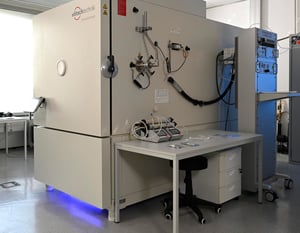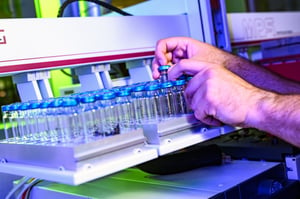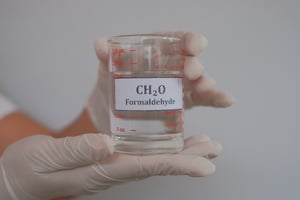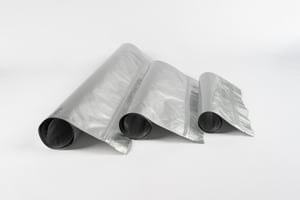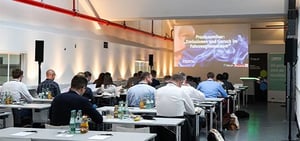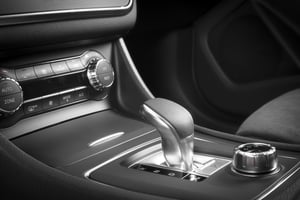
Fogging
Determination of the fogging behavior of materials used in vehicle interiors
FOGGING TEST IN THE
AUTOMOBILE INTERIOR
PRECISE ADHESION TESTS FOR THE HIGHEST QUALITY
In the automotive industry, paintwork is much more than just an aesthetic element. They play a decisive role in the protection and durability of vehicle components. Coatings protect against corrosion, weathering and mechanical stress. To ensure that this protective function is maintained even under extreme conditions - such as high temperatures, moisture or mechanical stress - it is essential that the paintwork adheres strongly to the underlying surface.
Adhesion tests are therefore a central component of quality control. They ensure that the paint layer is firmly bonded to the bodywork or other vehicle parts and can withstand external influences such as stone chipping, detachment or cracking. Poor adhesion can not only lead to aesthetic defects, but can also impair corrosion resistance and thus the structural integrity of the components.
Our adhesion tests determine whether your coatings adhere firmly even under the harshest conditions and do not lose their protective function. By using precise test methods, we give you the certainty that your vehicles are optimally protected.
The tests are carried out in accordance with strict industry standards, such as DIN EN ISO 2409 (cross-cut test). This involves mechanically testing the adhesion of the paintwork to ensure that it meets the requirements of the automotive industry. One of the main methods is the cross-cut test, in which adhesion is assessed by scratching a defined grid.
Our tests are used in numerous areas of application. Body parts such as doors, hoods and fenders are tested for paint adhesion, as are interior fittings such as plastic and metal parts. Chassis components that are exposed to particularly high mechanical loads, such as shock absorbers, axles or underbody parts, also benefit from the tests.
To ensure that the tests can be carried out precisely and reliably, the samples must be delivered in a clean and undamaged condition. Shockproof packaging helps to avoid damage during transportation. Detailed information on the coating, such as the coating system, drying method and material composition, is also required. Additional samples for repeat or comparative tests are recommended to maximize the significance of the results.
The tests take into account manufacturer-specific minimum requirements for adhesive strength and define maximum permissible peeling or cracking after mechanical stress. Our test conditions simulate real-life application scenarios to ensure that your coatings can withstand a wide range of environmental conditions.
Contact us to find out more about our test procedures!

Fogging test methods
- DIN 75201-A (reflectrometric)
- DIN 75201-B (gravimetric)
- PV 3015 (Volkswagen)
- GMW 3235-A (General Motors Worldwide)
- PSA D45 1727
- and much more.
Are you looking for an exam? Standard? Specifications?
Accredited & certified tests
CONTACT OUR EXPERTS
Description. Lorem ipsum dolor sit amet, consetetur sadipscing elitr, sed diam nonumy eirmod tempor invidunt ut labore et
- Tab Title






- 01 Purpose of the adhesion test
- 02 Test methods
Purpose of the adhesion test
- Ensuring adhesion: Ensuring that coatings are firmly bonded to the surface and can withstand external influences.
- Corrosion protection: Avoiding detachment that could impair the protective function of the paintwork and the structural integrity of the components.
- Quality control: Checking the durability and reliability of paintwork under realistic conditions.
- Avoidance of aesthetic defects: Ensuring that paint finishes are free from cracking, peeling or other visual degradation.
- Compliance with standards and specifications: Ensuring that paint finishes comply with automotive industry requirements, such as DIN EN ISO 2409.
- Optimization of materials and processes: Identifying weak points and improving paint coating systems and their application.
Test methods
Cross-cut test (cross-cut test)
Using a special cutting tool, a grid of parallel and perpendicular cuts is scratched into the paint layer.
The adhesion of the paintwork is assessed by the number and size of detachments at the cut edges.
This method is carried out in accordance with the DIN EN ISO 2409 standard and is frequently used in the automotive industry.
Frequently asked questions about the fogging test
The sample quantities required for a fogging test depend on the standard and the test method used. Here are the general guidelines:
1. standard DIN 75201 (type A and type B)
-
Type A (glass plate method):
A sample quantity of 10 cm² is typically required. The sample is placed on a heated plate in a sealed chamber and the volatiles released condense on a glass plate above. -
Type B (aluminum foil method):
Similar to type A, a sample volume of approximately 10 cm² is used. However, the volatile substances condense on a cooled aluminum foil.
2. standard ISO 6452 (international standard)
- Sample quantity:
Again, a sample size of about 10 cm² is typically required to evaluate the amount of volatiles released at elevated temperature.
3. other specific requirements
Depending on the specific requirements of the customer or OEM standards, sample quantities may vary. It is important to check the respective standards or test requirements carefully.
Method A - Reflectometric method:
- Principle: This method measures the change in reflectivity on a glass plate on which volatile components from the material sample are deposited.
- Procedure: A material sample is heated in a beaker while a glass plate above it is cooled to 21°C. The temperature difference causes the volatile components to condense on the glass plate. The reflectance index of the fogged glass plate is then measured to determine the amount of condensed material.
- Application: This method is particularly suitable for materials for which an exact determination of the optical fog effect is required.
Method B - Gravimetric method:
- Principle: This method measures the weight of condensed volatiles on an aluminum foil.
- Procedure: The material sample is heated in a beaker while an aluminum foil disc is cooled to 21°C. After 16 hours, the amount of condensed material on the foil is weighed.
- Application: This method is ideal for an accurate quantitative determination of the amount of condensed volatiles.
CONTACT US
CORROSION
Formaldehyd in Fahrzeugen: Herausforderungen für die Automobilindustrie
Read moreStellantis: Freigabe für Emissionsprüfungen erfolgreich (VIAQ)
Read moreVDA 277 vs. VDA 278: Was ist der Unterschied?
Read moreGeruchsunterschiede bei Polypropylen: Die Rolle von Faserverstärkung und Verarbeitungsparametern
Read moreWarum sind die Einheiten der Ergebnisse von Prüfungen der Werkstoffemissionen eigentlich so unterschiedlich?
Read moreGrenzwerte für Formaldehyd und Formaldehydabspaltern in Fahrzeugen
Read moreFREQUENTLY ASKED QUESTIONS ABOUT ADHESION TESTING
The samples must be clean and undamaged so as not to falsify the results. In addition, information on the coating, such as the coating system, material composition and drying method, should be included so that the test parameters can be precisely determined.


